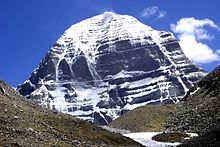Kailasha

Kailasha or Kailasa (
Etymology
The name is given as "Kailāsa" (कैलास; var. Kailāśa कैलाश) in Sanskrit.[2][3] It could have been derived from the word "kelāsa" (केलास), which means "crystal".[4]
Theology and mythology
The abode of Kailasha is said to be guarded by a set of
Hindus believe Kailasha to be the Mount Meru which is considered to be a stairway to Svarga, a heaven where the devas reside.[8] Meru is considered as the center of the universe and is said to be 139,440 km (86,640 mi) high, connecting the earth with the under world and heaven with Shiva residing on top of the mountain.[9]
According to the
The Hindu epic
The
Geographical location

Due to its perceived sacredness, people from India, Nepal and other countries undertake a pilgrimage called yatra to the mountain.[25][26] The pilgrimage involves trekking towards Lake Manasarovar and a circumambulation of Mount Kailasha. The path around Mount Kailasha is 53 km (33 mi) long. Pilgrims believe that doing a circumambulation of Mount Kailasha on foot is a spiritually beneficial practice that can bring various positive effects, such as the collection of meritorious karma, the cleansing of sins from one's consciousness, and good fortune. The circumambulation is made in a clockwise direction by the Hindus.[27]
See also
References
- ISBN 978-81-7625-039-9. Retrieved 6 September 2023.
- Monier-Williams. p. 311. Retrieved 1 December 2023.
- ^ "Entry for कैलासः". Apte Sanskrit-English Dictionary. Retrieved 1 December 2023.
- ^ Williams, Monier. "Monier-Williams Sanskrit-English Dictionary". Archived from the original on 31 August 2018. Retrieved 10 October 2017.
kelāsa m. crystal W
- ^ Bansal 2005, p. 59
- ^ Bansal 2005, p. 37
- ^ Bansal 2005, p. 42
- ^ Allen 1982, p. 21
- ^ Chamaria 1996, p. 17
- ^ Chamaria 1996, p. 25
- ^ Chamaria 1996, p. 24
- ^ Chamaria 1996, p. 25
- ^ "Mysteries of Kailash: What Are These 9-Foot Tall Entities Found In Mansarovar?". News24. 4 October 2023. Retrieved 1 December 2023.
- .
- ^ Chamaria 1996, p. 26
- ISBN 978-0-500-51088-9.
- ^ Allen 1982, p. 22
- ISSN 0896-0801. 70696022.
- ^ Chamaria 1996, p. 28
- ^ Chamaria 1996, p. 29
- ^ Chamaria 1996, p. 31
- S2CID 163370522.
- ^ Freeman Attwood (2003). "Gangdise Mountains" (PDF). Alpine Journal. 4: 103–109.
- ISBN 978-1-598-84654-6. Retrieved 4 April 2019.
- ^ "Kailash Manasarovar Yatra". Ministry of External Affairs, Government of India. Retrieved 30 July 2022.
- ^ Karen Swenson (16 March 2003). "A Sacred Circuit in Tibet". The New York Times. Retrieved 30 July 2022.
- ^ Bubriski, Kevin; Pandey, Abhimanyu (2018). Kailash Yatra: a Long Walk to Mount Kailash through Humla. New Delhi: Penguin Random House. p. 151.
Bibliography
- Bansal, Sunita Pant (2005). Hindu Gods and Goddesses. Smriti Books. ISBN 978-8-187-96772-9.
- Allen, Charles (1982). A Mountain in Tibet. Futura Publications. ISBN 0-7088-2411-0.
- Chamaria, Pradeep (1996). Kailash Manasarovar on the Rugged Road to Revelation. Abhinav Publications. ISBN 978-8-170-17336-6.
